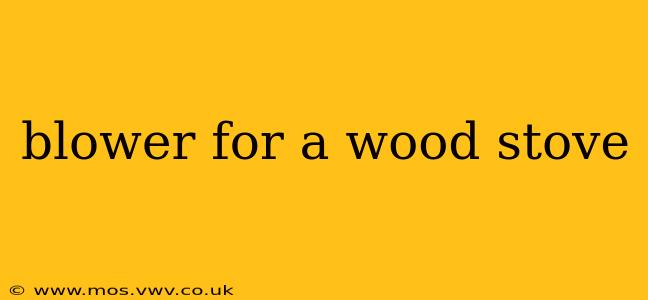A wood stove blower can significantly improve the efficiency and comfort of your wood-burning heating system. By circulating warm air throughout your space, it can make a noticeable difference in heating your home more evenly and effectively. This comprehensive guide will explore everything you need to know about choosing and using a wood stove blower, answering common questions and offering expert advice.
What are the Benefits of Using a Wood Stove Blower?
A wood stove blower offers several key advantages:
-
Improved Heat Distribution: Instead of heat rising directly from the stove, a blower circulates warm air, distributing it more evenly throughout the room and even adjacent rooms. This eliminates cold spots and creates a more comfortable environment.
-
Increased Efficiency: By improving heat circulation, a blower helps to extract more heat from the wood you burn, leading to potentially lower wood consumption over time.
-
Faster Heating: A blower can accelerate the heating process, getting your home up to temperature quicker, especially after initially starting the fire.
-
Enhanced Combustion: Some blowers assist with combustion by providing additional oxygen flow, leading to a cleaner and more efficient burn. However, this isn't a universal feature of all blowers.
How Does a Wood Stove Blower Work?
Wood stove blowers are relatively simple devices. They typically consist of a fan that draws in cool air and expels it as warm air. The fan is powered either by electricity (most common) or by the heat of the stove itself (thermoelectric blowers). Electric models require a power cord, while thermoelectric blowers are battery-free, relying on the temperature difference between the stove top and the ambient air to generate power.
What Types of Wood Stove Blowers Are Available?
There are several types of wood stove blowers on the market, each with its own advantages and disadvantages:
-
Electric Blowers: These are the most common type. They offer adjustable speed settings, allowing you to control the airflow and heat output. They require a power source.
-
Thermoelectric Blowers: These run on the heat of the stove, eliminating the need for electricity or batteries. They are generally quieter than electric models but usually offer less powerful airflow.
-
Battery-Powered Blowers: These offer portability and can be used in areas without a readily available power outlet. They require regular battery replacement.
-
High-Volume Blowers: Designed for larger rooms or those with less efficient heat distribution, these models move a larger volume of air but are usually louder than smaller models.
How Do I Choose the Right Wood Stove Blower for My Stove?
Selecting the right blower involves considering several factors:
-
Stove Size and Output: Larger stoves benefit from more powerful blowers capable of moving a greater volume of air. Check your stove's BTU output to help you determine the appropriate blower size.
-
Room Size: The size of the room you want to heat will influence the required airflow of the blower. Larger rooms necessitate stronger blowers.
-
Power Source: Decide between electric, thermoelectric, or battery-powered based on your needs and preferences. Consider the convenience and cost implications of each type.
-
Noise Level: Some blowers are quieter than others. If noise is a concern, choose a model with a lower decibel rating.
-
Safety Features: Look for blowers with features like overheat protection to prevent accidents.
What Safety Precautions Should I Take When Using a Wood Stove Blower?
-
Proper Placement: Always follow the manufacturer's instructions regarding the safe placement of the blower. Ensure it's positioned away from flammable materials and properly ventilated.
-
Overheat Protection: Choose a blower with built-in overheat protection to prevent damage to the unit or fire hazards.
-
Electrical Safety (Electric Blowers): Ensure the blower is plugged into a properly grounded outlet. Avoid using extension cords whenever possible.
-
Regular Maintenance: Clean the blower regularly to remove dust and debris that can affect its performance and safety.
Can a Wood Stove Blower Damage My Stove?
A properly installed and maintained wood stove blower shouldn't damage your stove. However, using an inappropriately sized or poorly designed blower could potentially cause problems. Always choose a blower that is compatible with your stove's size and design.
How Much Does a Wood Stove Blower Cost?
The cost of a wood stove blower varies widely depending on the brand, features, and type. Expect to pay anywhere from a few tens of dollars for a basic model to several hundred dollars for a high-end, powerful blower.
Where Can I Buy a Wood Stove Blower?
Wood stove blowers are available from various retailers, including home improvement stores, online marketplaces, and specialty wood stove suppliers. Always check reviews before purchasing to gauge the quality and reliability of the product.
This comprehensive guide provides a solid foundation for understanding and selecting a wood stove blower that meets your specific needs. Remember to always prioritize safety and follow the manufacturer's instructions for optimal performance and longevity.
